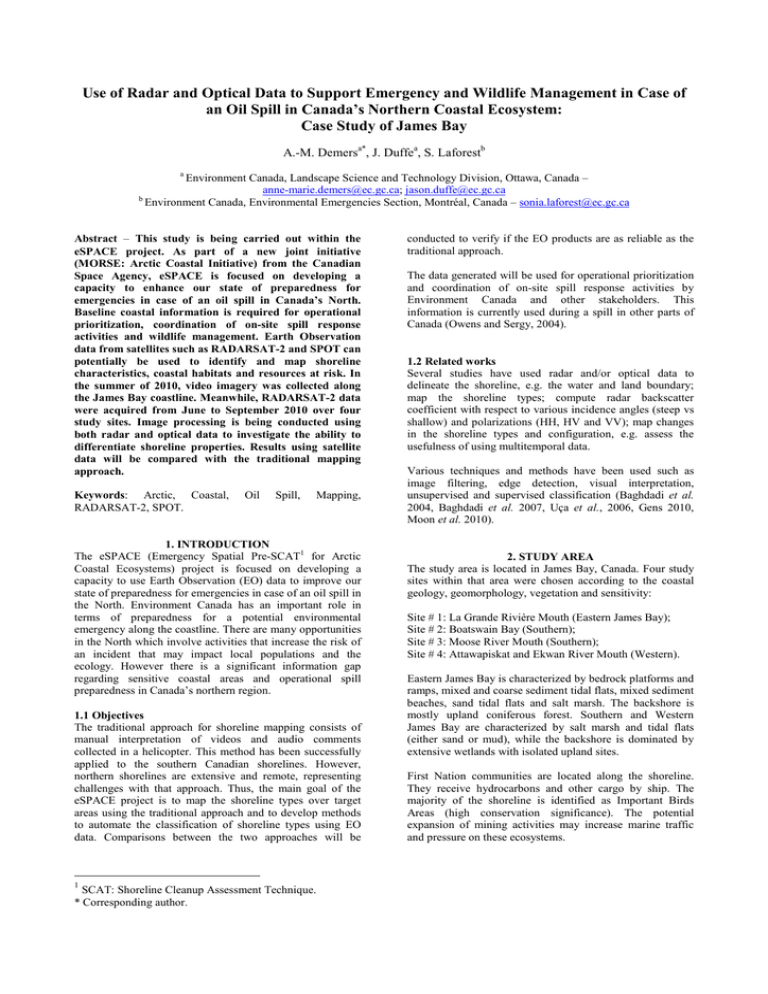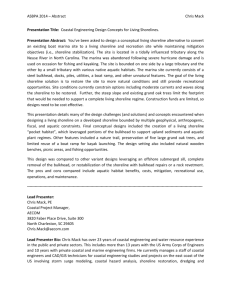Use of Radar and Optical Data to Support Emergency and... an Oil Spill in Canada’s Northern Coastal Ecosystem:
advertisement

Use of Radar and Optical Data to Support Emergency and Wildlife Management in Case of an Oil Spill in Canada’s Northern Coastal Ecosystem: Case Study of James Bay A.-M. Demersa*, J. Duffea, S. Laforestb a Environment Canada, Landscape Science and Technology Division, Ottawa, Canada – anne-marie.demers@ec.gc.ca; jason.duffe@ec.gc.ca b Environment Canada, Environmental Emergencies Section, Montréal, Canada – sonia.laforest@ec.gc.ca Abstract – This study is being carried out within the eSPACE project. As part of a new joint initiative (MORSE: Arctic Coastal Initiative) from the Canadian Space Agency, eSPACE is focused on developing a capacity to enhance our state of preparedness for emergencies in case of an oil spill in Canada’s North. Baseline coastal information is required for operational prioritization, coordination of on-site spill response activities and wildlife management. Earth Observation data from satellites such as RADARSAT-2 and SPOT can potentially be used to identify and map shoreline characteristics, coastal habitats and resources at risk. In the summer of 2010, video imagery was collected along the James Bay coastline. Meanwhile, RADARSAT-2 data were acquired from June to September 2010 over four study sites. Image processing is being conducted using both radar and optical data to investigate the ability to differentiate shoreline properties. Results using satellite data will be compared with the traditional mapping approach. Keywords: Arctic, Coastal, RADARSAT-2, SPOT. Oil Spill, Mapping, 1. INTRODUCTION The eSPACE (Emergency Spatial Pre-SCAT1 for Arctic Coastal Ecosystems) project is focused on developing a capacity to use Earth Observation (EO) data to improve our state of preparedness for emergencies in case of an oil spill in the North. Environment Canada has an important role in terms of preparedness for a potential environmental emergency along the coastline. There are many opportunities in the North which involve activities that increase the risk of an incident that may impact local populations and the ecology. However there is a significant information gap regarding sensitive coastal areas and operational spill preparedness in Canada’s northern region. 1.1 Objectives The traditional approach for shoreline mapping consists of manual interpretation of videos and audio comments collected in a helicopter. This method has been successfully applied to the southern Canadian shorelines. However, northern shorelines are extensive and remote, representing challenges with that approach. Thus, the main goal of the eSPACE project is to map the shoreline types over target areas using the traditional approach and to develop methods to automate the classification of shoreline types using EO data. Comparisons between the two approaches will be 1 SCAT: Shoreline Cleanup Assessment Technique. * Corresponding author. conducted to verify if the EO products are as reliable as the traditional approach. The data generated will be used for operational prioritization and coordination of on-site spill response activities by Environment Canada and other stakeholders. This information is currently used during a spill in other parts of Canada (Owens and Sergy, 2004). 1.2 Related works Several studies have used radar and/or optical data to delineate the shoreline, e.g. the water and land boundary; map the shoreline types; compute radar backscatter coefficient with respect to various incidence angles (steep vs shallow) and polarizations (HH, HV and VV); map changes in the shoreline types and configuration, e.g. assess the usefulness of using multitemporal data. Various techniques and methods have been used such as image filtering, edge detection, visual interpretation, unsupervised and supervised classification (Baghdadi et al. 2004, Baghdadi et al. 2007, Uça et al., 2006, Gens 2010, Moon et al. 2010). 2. STUDY AREA The study area is located in James Bay, Canada. Four study sites within that area were chosen according to the coastal geology, geomorphology, vegetation and sensitivity: Site # 1: La Grande Rivière Mouth (Eastern James Bay); Site # 2: Boatswain Bay (Southern); Site # 3: Moose River Mouth (Southern); Site # 4: Attawapiskat and Ekwan River Mouth (Western). Eastern James Bay is characterized by bedrock platforms and ramps, mixed and coarse sediment tidal flats, mixed sediment beaches, sand tidal flats and salt marsh. The backshore is mostly upland coniferous forest. Southern and Western James Bay are characterized by salt marsh and tidal flats (either sand or mud), while the backshore is dominated by extensive wetlands with isolated upland sites. First Nation communities are located along the shoreline. They receive hydrocarbons and other cargo by ship. The majority of the shoreline is identified as Important Birds Areas (high conservation significance). The potential expansion of mining activities may increase marine traffic and pressure on these ecosystems. 3. DATA ACQUISITION 3.1 Fieldwork Helicopter surveys were conducted in July 2010 at low altitude (400 feet) and low tide. Oblique video and audio were recorded along the shoreline as well as GPS coordinates and time. While flying over the shoreline, the interpreter was describing the upper intertidal zone and the backshore with respect to their geology, geo-morphology (grain sizes and sediment type) and vegetation (Owens, 2010). 3.2 Satellite data RADARSAT-2 data were acquired over each study site (Table A) covering different periods of time in 2010 (maximum growth vegetation, dead vegetation, low and high tide) to take advantage of various ground conditions (surface roughness and soil moisture). All study sites are covered with Fine Quad Mode (8m; amplitude and phase information) and three incidence angles (steep, medium and shallow), while two sites are also covered with Ultrafine Mode (3m, single polarization HH). All study sites are covered with optical data acquired at maximum growth vegetation (Table B). Table A. RADARSAT-2 acquired for each study sites Study Sites Site # 1 Site # 2 Site # 3 Site # 4 RADARSAT-2 data FQ4: 2010 06 26; FQ4: 2010 08 13 FQ12: 2010 07 06; FQ28: 2010 07 02; FQ28: 2010 09 12 FQ6: 2010 07 13; FQ6: 2010 08 06 FQ14: 2010 06 29; FQ27: 2010 08 19 FQ4: 2010 07 06; FQ4: 2010 08 23 FQ16: 2010 07 09; FQ16: 2010 09 19 FQ29: 2010 07 12; FQ29: 2010 09 22 U19: 2010 07 19; U19: 2010 09 05 U77: 2010 07 23; U77: 2010 09 09 FQ3: 2010 06 29; FQ3: 2010 08 16 FQ31: 2010 06 28; FQ31: 2010 08 15 FQ11 2010 08 26; U12: 2010 07 19; U12: 2010 09 05 U71: 2010 07 23 ; U71: 2010 09 09 Table B. Optical data available for each study sites Study Sites Site # 1 Site # 2 Site # 3 SPOT SPOT-5 2007 08 26 SPOT-4 2008 07 20 SPOT-5 2006 09 01 Site # 4 SPOT-4 2008 07 20 SPOT-5 2006 06 20 LANDSAT-7 2001 08 21 2002 06 21 2002 06 21 2000 08 09 2000 07 15 4. SHORELINE SEGMENTATION (Traditional approach) Shoreline segmentation is the process of dividing the coastline into working units (segments) within which the shoreline character is homogeneous in terms of physical features and sediment type (Owens and Sergy, 2004). The first step is to divide the shoreline into segments according to observed changes in the upper part of the intertidal zone (the upper approximate one-third of the intertidal zone, up to the mean high water mark). This is the area where the oil would be deposited and where the clean-up activities would take place (Owens, 2010). A data entry form has been created in order to collect the data required by the SCAT team, such as the shoreline type, primary substrates, slope, exposure, resources at risk, on-site accessibility; as well as for the EO needs, such as physical features that can be seen in the videos (e.g., color, texture and contextual information) which are used to assign a shoreline type (Boak and Turner, 2005). During the second and last step these data are entered into the form for each segment. 5. SHORELINE ANALYSIS WITH EARTH OBSERVATION DATA As a first step, radar and optical data analysis will be conducted independently to determine the most suitable techniques, optimal datasets and methods to discriminate the shoreline and backshore types. Radar analysis will be conducted with respect to changes in the incidence angles, polarizations and acquisition time (tidal height, vegetation growth and weather conditions). In further steps, textural analysis, filters and polarimetric parameters will be generated (Touzi et al., 2009). Quantitative and qualitative assessments will be conducted to determine if these images improve the shoreline and backshore discrimination. Classifications techniques (polarimetric, object-based, decision tree and traditional classifiers) will be performed with the optimal datasets (radar and optical) determined from the previous steps. Ancillary datasets such as hydrologic network, surface deposits maps and wind data will be assessed as part of the classification procedure. Complementarity between radar and optical data will be assessed with respect to the results obtained with the traditional approach. RADARSAT-2 data are being orthorectified and training sites are being created for some study sites. REFERENCES N. Baghdadi, R. Pedreros, N. Lenotre, T. Dewez and N. Paganini. 2007. Impact of polarization and incidence of the ASAR sensor on coastline mapping: example of Gabon. International Journal of Remote Sensing, vol 28, no 17, pp.3841-3849. N. Baghdadi, N. Gratiot, J.-P. Lefebvre, C. Oliveros and A. Bourguignon. 2004. Coastline and mudbank monitoring in French Guiana: contributions of radar and optical satellite imagery. Canadian Journal of Remote Sensing, vol 30, no 2, pp. 109-122. E.H. Boak and I.L. Turner. 2005. Shoreline Definition and Detection: A Review. Journal of Coastal Research, vol 21, no 4, pp. 688-703. R. Gens. 2010. Remote sensing of coastlines: detection, extraction and monitoring. International Journal of Remote Sensing, vol. 31, no 7, pp. 1819-1836. W.M. Moon, G. Staples, D.-J., Kim, S.-E. Park, and K.-A. Park. 2010. RADARSAT-2 and Coastal Applications: Surface Wind, Waterlin, and Intertidal Flat Roughness. Proceedings of the IEEE, vol 98, no 5, pp. 800-815. E.H. Owens. 2010. Primary Shoreline Types of the Canadian North. 60p. E.H. Owens, and G.A. Sergy. 2004. The Arctic SCAT Manual. A Field Guide to the Documentation of Oiled Shorelines in Arctic Regions, 164p. R. Touzi, A. Deschamps, G. Rother. 2000. Phase of Target Scattering for Wetland Characterization Using Polarimetric C-Band SAR. IEEE Transactions on Geoscience and Remote Sensing, vol. 47, no 9, pp. 3241-3259. Z.D. Uça, F. Sunar Erbek, L. Kusak, F. Yasa and G. Ozden. 2006. The use of optic and radar satellite data for coastal environments. International Journal of Remote Sensing, vol.27, no 17, pp.3739-3747. ACKNOWLEDGEMENTS Thanks to the Canadian Space Agency, ECRC/SIMEC and The Grand Council of the Crees (Eeyou Istchee) for their support.




